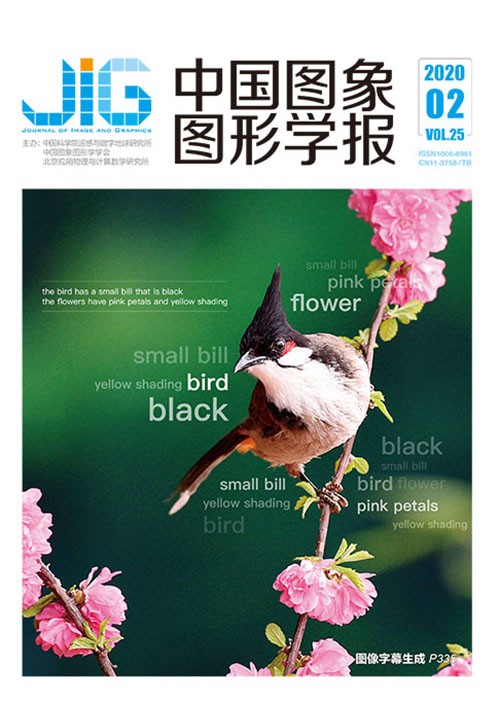
多尺度双通道卷积神经网络下的刺绣模拟
摘 要
目的 针对现有刺绣模拟算法中针线感不强、针线轨迹方向单一等问题,提出了一种基于多尺度双通道卷积神经网络的刺绣模拟算法。方法 1)搭建多尺度双通道网络,选取一幅刺绣艺术作品作为风格图像,将MSCOCO(microsoft common objects in context)数据集作为训练集,输入网络得到VGG(visual geometry group)网络损失和拉普拉斯损失;2)将总损失值传回到网络,通过梯度下降法更新网络参数,并且重复更新参数直到指定的训练次数完成网络训练;3)选取一幅目标图像作为刺绣模拟的内容图像,输入训练完成的网络,获得具有刺绣艺术风格的结果图像;4)使用掩模图像将得到的结果图像与绣布图像进行图像融合,即完成目标图像的刺绣模拟。结果 本文算法能产生明显的针线感和多方向的针线轨迹,增强了刺绣模拟绘制艺术作品的表现力。结论 本文将输入图像经过多尺度双通道卷积神经网络进行前向传播,并使用VGG19、VGG16和拉普拉斯模块作为损失网络进行刺绣模拟。实验结果表明,与现有卷积神经网络风格模拟算法对比,本文提出的网络能够学习到刺绣艺术风格图像的针线特征,得到的图像贴近真实刺绣艺术作品。
关键词
Embroidery simulation based on multi-scale two-channel convolution neural network
Li Zongyan, Qian Wenhua, Xu Dan, Pu Yuanyuan(Department of Computer Science and Engineering, Yunnan University, Kunming 650504, China) Abstract
Objective Embroidery, a unique handicraft technology in China, has high artistic and commodity value. The production of realistic embroidery works of art requires considerable time and strict manual skills. With the development of modern science and technology, the use of computer algorithms to simulate the generation of embroidery art style images is crucial for the protection and inheritance of embroidery culture. Traditional embroidery simulation algorithm has limitations and requires the designer to understand embroidery stitching. Convolutional neural network can learn the characteristics of embroidery artistic style to simulate the generation of embroidery artistic style on different images. Therefore, to address the problem that the existing embroidery art style simulation algorithm produces nonevident needle characteristics and single needle direction, this paper proposes an embroidery simulation algorithm based on multi-scale two-channel convolution neural network. Method Multi-scale two-channel convolution neural network, VGG19 network, VGG16 network, and Laplacian module are used to learn and extract texture features of embroidery art style images, and the learned texture features are simulated and generated in content images. The content image becomes the image with the characteristics of embroidery art. First, the overall structure of the convolution neural network is determined by using deep convolutional generative adversarial network. A multi-scale two-channel convolution neural network is constructed as the generating network. The concrete structure of the network consists of multi-scale input, dual-channel convolution blocks propagating simultaneously in the RGB and gray channels, and integrated convolution blocks. VGG19 network, VGG16 network, and Laplacian module are used as loss networks. The real image of embroidery works is selected as the style image of embroidery art, and the MSCOCO image dataset is used as the training data. The training data are input into the network, and the VGG network and Laplacian loss values are obtained by calculating the loss network. The total loss value is returned to the multi-scale two-channel convolution neural network, and the gradient descent method is used to update the convolution neural network. Parameters are repeated until a specified number of network training iterations complete the training of the multi-scale two-channel convolution neural network; a target image is selected as the content image input to the multi-scale two-channel convolution neural network that has been trained, such that the content image becomes an image with embroidery artistic characteristics. At this time, the embroidery art style simulation of the content image is preliminarily completed. Finally, the mask image of the content image is used to fuse the generated image with the background image. The content image part that needs to be simulated as the foreground image is retained, whereas the other part of the image is displayed as the background image to complete the simulation of the embroidery art style of the content image. Result The embroidery simulation result image obtained by the algorithm in this paper is compared with the embroidery simulation result image obtained by some existing convolutional neural networks. Result images obtained by the existing convolutional neural networks do not show fine needle-line characteristics and the style is further inclined to artistic painting style. Even if the obtained embroidery simulation result images show clear embroidery texture, but the needle-line direction is evidently single and the gap between the textures is large, the comparison with the real embroidery texture is insufficiently natural. The simulated image of embroidery artistic style obtained by the multi-scale and dual-channel convolution neural network presented in this paper has evident needle-line characteristics and multi-direction needle-line trajectory. This method solves the existing problems in generating the effect image of embroidery artistic style by using the existing simulation algorithm and efficiently displays the artistic characteristics of embroidery. Conclusion In this paper, the target image is forward-propagated through a multi-scale two-channel convolutional neural network, and VGG19 network, VGG16 network, and Laplacian module are used as the loss networks to simulate the embroidery art style. Experimental results show that in comparison with the results of the existing convolutional neural network for the style simulation, the proposed multi-scale two-channel convolutional neural network can learn the detailed stitching features in the embroidery style art image, and the final result image is displayed. With a clear sense of stitching and multi-directional stitching, the overall artistic style is close to real embroidery art. In future work, we will focus on embroidery texture connection and transition generation in different areas of the existing generated result image to make the final embroidery art style simulation image close to the actual embroidery art work.
Keywords
embroidery simulation convolutional neural network (CNN) multi-scale two-channel VGGNet loss Laplacian loss
|



 中国图象图形学报 │ 京ICP备05080539号-4 │ 本系统由
中国图象图形学报 │ 京ICP备05080539号-4 │ 本系统由